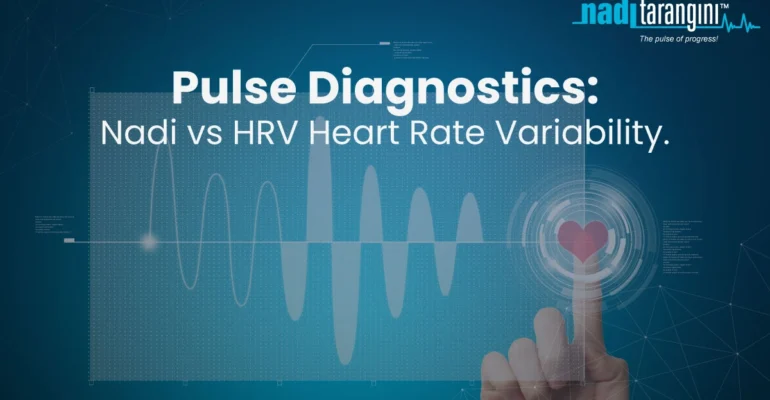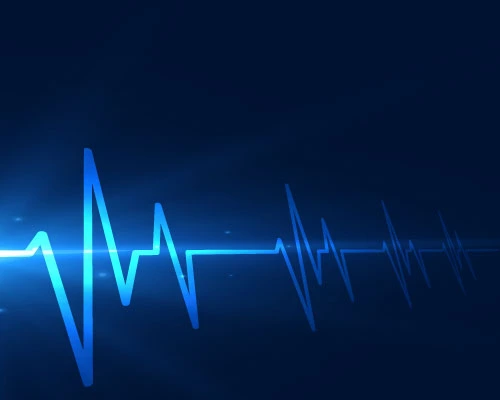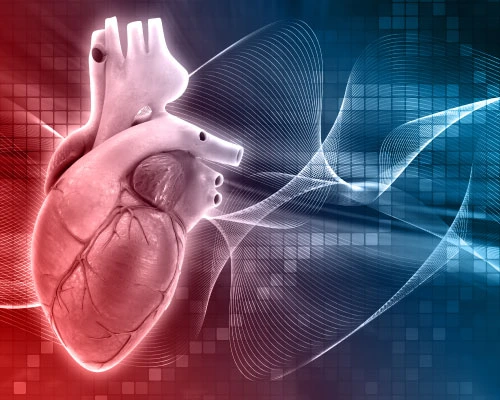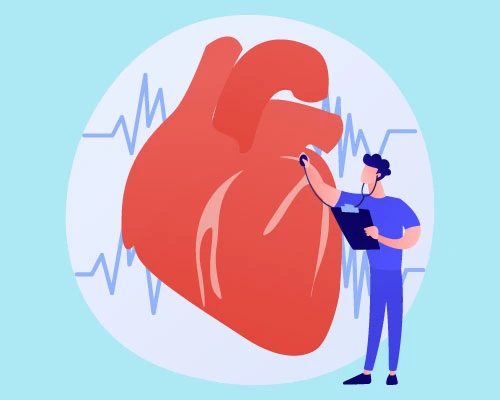Pulse Diagnostics: Nadi Vs HRV Heart Rate Variability

Pulse Diagnostics: Nadi Vs HRV Heart Rate Variability
Nadi pariksha described by Ayurveda is altogether different than pulse rate measurement.
Ayurveda emphasizes importance of Nadi Pariksha for understanding predominant dosh responsible for pathogenesis, prognosis and prediction of the stage of particular disease along with its causative factors.
Pulse rate, also known as your heart rate, is the number of times your heart beats per minute. A normal resting heart rate should be between 60 to 100 beats per minute, but it can vary from minute to minute. Pulse rate indicates the contractions of the heart per minute. Abnormal Heart Rate or Heart Beats indicates abnormalities in cardiac functioning.
Pulse rate is not exact and accurate diagnostic tool but it is indicative or suggestive diagnostic tool which can lead to further investigation. Pulse rate varies according to age, stress, anxiety, or certain medications and with some physiological phenomena.
In short, pulse rate is quantitative assessment while Nadi is qualitative assessment of pulse felt at Radial artery.
Going further, some of the qualitative parameters of pulse are assessed with the help of ECG i.e. Electro Cardio Gram or other biomedical instruments through graphs generated by pulse waves. Pulse velocity, heart rate variability, arterial stiffness are some of these qualitative parameters which got assessed by advanced biomedical devices. These parameters are proven indicators of underlying pathologies. Means this qualitative assessment of pulse wave are exact, non-invasive diagnostic tool on which treatment protocols are based.
Though Nadi and pulse are conceptually different entities, some qualitative parameters of Nadi mentioned by Ayurveda are significantly similar with qualitative parameters of pulse wave described by modern science. One of the very important parameter similar with the qualitative assessment of pulse rate is HRV i.e. Heart Rate Variability.
Parameters observed during Nadi Pariksha:
To know more further, let’s understand the parameters mentioned by Ayurveda which has to be observed during Nadi pariksha. Nadi velocity, frequency and some of the Gunas like mand, guru, laghu, sthira are indicated for qualitative assessment of Nadi. It’s methodology for observation, perception and interpretation is thoroughly described by Ayurveda.
Nadi pariksha can be done by putting three fingers in position over Nadi i.e. near base of the thumb and it indicates the underlying condition of the Tridosha. The index finger denotes vata dosha, the middle finger denotes pitta and the ring finger denotes kapha dosha. Prominent perception of Nadi below the particular finger denotes dosha Predominance after applying particular pressure tactics. Apart from that, Vaidyas observe different gunas, gati of Nadi for further interpretation.
Health is balances within three dosha, dhatu and mala which leads to sound physical and psychological state of mind. Vitiated doshas lead to diseases which can be assessed with the help of Nadi pariksha which is non invasive tool that has been used from thousands of years by Ayurveda.
With more specifications and diagnosis, Nadi gati is very specific entity mentioned by Ayurveda while describing Nadi pariksha. The perception of the pulse with respect to gati is different with different dosha Predominance.
The speed, stability and gati (pulse velocity) of the pulse vary with the aggravated doshas and assessing such variations with Nadi pariksha is an art and science of its own. The traditional Ayurveda practitioners were adopting in pulse-based diagnosis and used to diagnose the diseases effectively by just placing fingers on the radial artery.Different gunas i.e. qualities like manda (slow), sthira (stable), chapala (fast) and kathina (hard) can be also assesed with the help of Nadi.
These qualities or properties of Nadi are measurable and can be associated to modern pulse parameters. The terms manda (slow) and chapala (fast) correspond to the speed or velocity of the pulse. Pulse velocity and its abnormalities also significantly decodes abnormalities in cardiovascular functioning.
The main and significant Nadi guna to be assessed is Shtiratva. Gati sthiratva or wave formation patterns of the Nadi should be very stable. The deflection in Sthiratva i.e. chapala or mand Nadi is associated with many disorders or also sign of Arishta (early signs of death) explained by Ayurveda.

The ayurveda classics have discussed the stability of the pulse in detail with a mention of intermittent Nadi which will be sometimes slow, sometimes fast and sometimes stops in between.
This stability or sthirtva of Nadi is very much resembles with associated to modern parameter pulse rate variability. As stable pulse is more rhythmic in nature the term tala which corresponds to rhythm can also be used to represent stability of the pulse
The stability of the pulse also depends on various physiological and psychological states of the person according to both Ayurveda and modern science
Heart rate variability (HRV) and Nadi Pariksha:
Heart rate variability (HRV) is the physiological phenomenon of variation in the time interval between heartbeats. It is measured by the variation in the beat-to-beat interval. HRV shows you the time interval between two heartbeats, measured in milliseconds (ms).

A normal HRV for people in their teens and 20s averages between 55 and 105 milliseconds, but most folks aged 60 years and up have lower heart rate variability, averaging between 25 to 45 milliseconds.
Heart rate variability (HRV) is a valuable indicator of mental and physical health. It can quantify your energy levels and even predict when your heart will stop beating. Given the mind-body connection, this could theoretically measure your mental fitness progress.
As your brain processes information and reacts to stimuli, it transmits signals to the rest of your body through the ANS to either stimulate or relax certain functions. When your system is in fight-or-flight mode, the variation or difference between heartbeats is minimal, and when it is relaxed, the variation is significant.
Although your heart rate may be 60 bpm, it does not mean that there has been a gap of one second between two heartbeats. One set of heartbeats may be at an interval of 1.3 seconds, whereas the next two may be at an interval of 0.7 seconds.
Your HRV is influenced by several physical and psychological factors and is an important parameter to measure whether your ANS is healthy or imbalanced.
Low HRV may thus indicate poor health that can contribute to mental health problems such as depression and anxiety and even some cardiovascular diseases.

HRV may be monitored using a specialized continuous electrocardiogram (ECG) monitoring device or commonly available heart rate monitors.
Meaning the traditionally rhythm of the pulse and different variation with its interpretation was described already by Ayurveda.
This qualitative assessment of Sthira guna of the Nadi deeply emphasizes not only your cardiovascular condition but overall physical and psychological health. Abnormalities in this pattern show increased stress levels, anxiety, depression, sleep deprivation like psychological entities.
With instruments like Nadi Tarangini, it is possible now to assess Gunas of Nadi especially sthiratva of Nadi by obtaining pulse wave forms. This will be clear indicator to understand physical as well as physiological health.
There are no equivalent terms in traditional texts which can be compared with HRV but intermittent Nadi can be closely associated to HRV as the nature of intermittent Nadi can be well understood by looking into pulse rate variability.
Missing peaks, beat to beat alterations in pulse interval are some of the important parameters can be assessed as further specific diagnostic tools accompanied with Ayurvedic principles

The beat-to-beat alterations of the pulse wave acquired using Nadi Tarangini showed significant variations across different age groups and disorders. This variation is the subject for research for further specific analysis.
Ayurveda has rich experience in pulse-based diagnosis but it is subjective in nature and is highly dependent on skill of the physician.
Nadi Tarangini a sensor based patented tool used for Nadi pariksha will prove promising solution for early detection of minute changes within body and will provide apt lifestyle modifications based on Ayurvedic principles.
For regular updates, like and follow:

